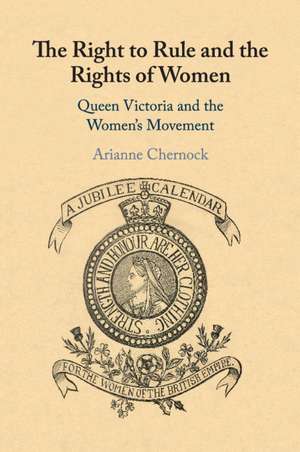The Right to Rule and the Rights of Women: Queen Victoria and the Women's Movement
Autor Arianne Chernocken Limba Engleză Paperback – 19 aug 2020
| Toate formatele și edițiile | Preț | Express |
|---|---|---|
| Paperback (1) | 283.63 lei 6-8 săpt. | |
| Cambridge University Press – 19 aug 2020 | 283.63 lei 6-8 săpt. | |
| Hardback (1) | 695.59 lei 6-8 săpt. | |
| Cambridge University Press – 7 aug 2019 | 695.59 lei 6-8 săpt. |
Preț: 283.63 lei
Nou
Puncte Express: 425
Preț estimativ în valută:
54.28€ • 58.94$ • 45.59£
54.28€ • 58.94$ • 45.59£
Carte tipărită la comandă
Livrare economică 22 aprilie-06 mai
Preluare comenzi: 021 569.72.76
Specificații
ISBN-13: 9781108735377
ISBN-10: 1108735371
Pagini: 261
Dimensiuni: 153 x 230 x 13 mm
Greutate: 0.35 kg
Editura: Cambridge University Press
Colecția Cambridge University Press
Locul publicării:Cambridge, United Kingdom
ISBN-10: 1108735371
Pagini: 261
Dimensiuni: 153 x 230 x 13 mm
Greutate: 0.35 kg
Editura: Cambridge University Press
Colecția Cambridge University Press
Locul publicării:Cambridge, United Kingdom
Cuprins
List of figures; Acknowledgments; Introduction: a mad, wicked folly?; 1. The radicalism of female rule in eighteenth-century Britain; 2. 'An argument of a very popular character': Queen Victoria in the early women's movement, c. 1832–76; 3. Rethinking the 'right to rule' in Victorian Britain; 4. The anti-suffragists' Queen; 5. 'No more fitting commemoration'?: Reclaiming Victoria for the women's movement during the Golden and Diamond Jubilees; Conclusion: Queen Victoria versus the suffragettes: the politics of queenship in Edwardian Britain; A note on sources; Bibliography; Index.
Recenzii
'How did, could, and should women hold political power? Arianne Chernock ingeniously probes invocations and imaginings of Queen Victoria to deliver an entirely fresh account of British women's rights. This elegant, perceptive book will be as valuable for historians of the Victorian era as it is resonant for anyone interested in how sovereignty and political activism work.' Maya Jasanoff, Harvard University, Massachusetts
'A careful analysis of what two opposing political movements - women's rights activists and social conservatives - saw when they looked at Victoria, and the uses to which each group tried to put the Queen. Chernock's argument that anti-suffragists helped lay the foundation for Britain's profoundly apolitical modern monarchy is provocative, new, and important.' Susie Steinbach, Hamline University, Minnesota
'Chernock makes scrupulous use of myriad digital and original primary sources (periodicals, pamphlets, papers, letters, etc.) in this essential analysis of how the British women's movement, notwithstanding Victoria's silent opposition and the partisan manipulation of her name, gained the same parliamentary suffrage as men in 1918, when power politics aligned better with moral right.' J. T. Mellone, Choice
'Chernock's excellent book deserves wide readership. This deeply researched, smart, and well-crafted work does more than explore the relationship of Queen Victoria to the women's movement. It provides a valuable analysis of political movements and the power of representation more generally, and explains one of the most important developments in British politics in the nineteenth century. Its lessons resonate to this very day.' Susan Kingsley Kent, The Journal of Modern History
'Chernock's contribution is both entirely unique and offers a fascinating new interpretation of one aspect of the monarch's life.' Connor E. R. DeMerchant, Royal Studies Journal
'A careful analysis of what two opposing political movements - women's rights activists and social conservatives - saw when they looked at Victoria, and the uses to which each group tried to put the Queen. Chernock's argument that anti-suffragists helped lay the foundation for Britain's profoundly apolitical modern monarchy is provocative, new, and important.' Susie Steinbach, Hamline University, Minnesota
'Chernock makes scrupulous use of myriad digital and original primary sources (periodicals, pamphlets, papers, letters, etc.) in this essential analysis of how the British women's movement, notwithstanding Victoria's silent opposition and the partisan manipulation of her name, gained the same parliamentary suffrage as men in 1918, when power politics aligned better with moral right.' J. T. Mellone, Choice
'Chernock's excellent book deserves wide readership. This deeply researched, smart, and well-crafted work does more than explore the relationship of Queen Victoria to the women's movement. It provides a valuable analysis of political movements and the power of representation more generally, and explains one of the most important developments in British politics in the nineteenth century. Its lessons resonate to this very day.' Susan Kingsley Kent, The Journal of Modern History
'Chernock's contribution is both entirely unique and offers a fascinating new interpretation of one aspect of the monarch's life.' Connor E. R. DeMerchant, Royal Studies Journal
Notă biografică
Descriere
Reveals Queen Victoria as a ruler who captivated feminist activists - with profound consequences for nineteenth-century culture and politics.
